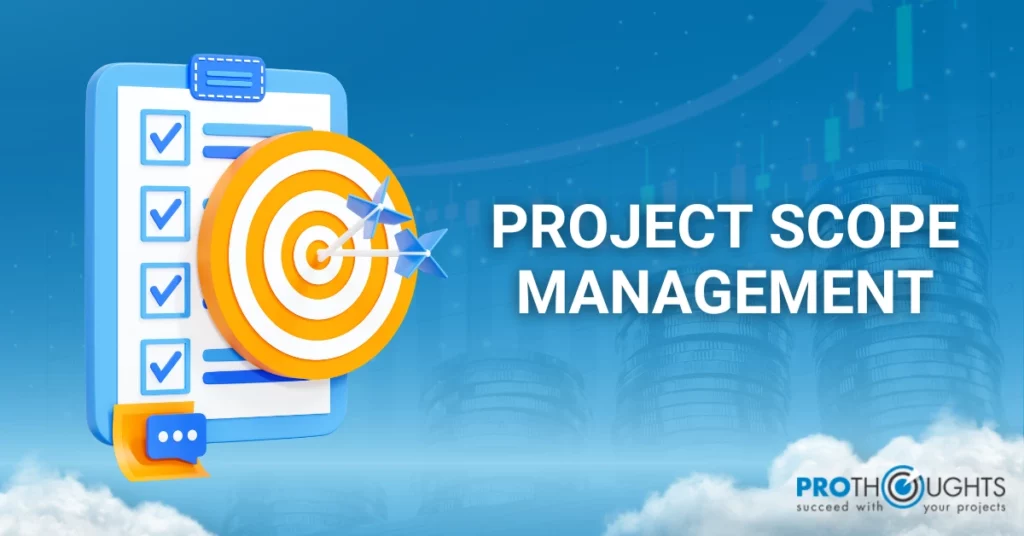Managing the scope of a project is crucial for the completion of its success. It’s an essential part of running any project team since it maximizes productivity, eliminates unnecessary or redundant tasks, and keeps everyone on the same page. The project’s scope aids in customer expectation management to keep the project on track and under budget.
Project Scope Management is the process mainly concerned with regulating what is and is not part of the project’s scope when mapping the project’s scope correctly. Scope Management approaches allow project managers and supervisors to distribute the appropriate amount of work necessary to complete a task effectively.
PMP Certification stands for Project Management Professional certification. This certification is the gold standard in the field of Project Management. ProThoughts provides the best PMP certification online training. We provide the best training practices such as flashcards, mock tests, and the very exclusive Rita Mulcahy material. Thus, ProThoughts Solutions’ PMP Certification makes becoming a qualified project manager easy.
What is Project Scope Management?
The processes need to be carried out before a “project,” which might be a product, service, or outcome with defined features and capabilities. Thus, it can be delivered and is called “Project Scope Management.” At the core of scope management lies “how we get there” or, more specifically, “what steps we take to get there.” Project managers and supervisors use these phases to construct and draw out a tool that assists them in estimating the amount of time and resources necessary to complete the project.
On the other hand, Product Scope Management is not to be mistaken with Project Scope Management. Product Scope Management’s primary focus is on the actual functionality of the product or service being managed. This form of scope details the product’s essence, appearance, and behavior, regardless of whether it describes the product in its entirety or simply one of its components.
The Project Scope Management involves the following steps:
-
Establish What Must Be Done
The first stage in creating a project plan, schedule, and objectives is defining the requirements. The project’s breadth can only be understood with these outlined measures, which is why they’re essential. After that, team members can be given assignments and instructions to complete the project within the specified time frame and financial constraints.
2. Learn the Aims of the Project
Establishing the project’s goals—launching a new product, introducing a new service within the organization, or creating new software—is the next step in defining the project’s scope. The project manager ensures the team produces outcomes following the stated features or functions.
3. Figure Out What Needs to Be Done
The resources and time spent on a project are its defining characteristics, as are the tasks involved in its completion. The scope is a high-level description of what must be done and how.
4. Scope Management for Plans
How the scope will be specified, validated, and controlled are all aspects of the Project Scope Management strategy. Information on how to avoid or deal with scope creep, how to handle requests for changes, how to escalate conflicts with over-scope items, how a work breakdown structure (WBS) will be developed, and how a project’s deliverables will be accepted are all included.
Here is what the Project Scope Management Plan looks like:
What are the Project Scope Management Processes?
Project scope management is an integral part of any planning process. You need a detailed strategy to ensure that everyone knows what to expect and how they will contribute.
-
Scope Management Planning.
It is the initial step in managing the scope of a project. The PMBOK Guide introduced several new processes to set the start of the planning phase. We develop a strategy for Scope Management during this step. The Scope Management plan details the project’s scope and the processes used to define, verify, and manage it.
The Project Scope Management plan details the procedures for defining, validating, and controlling the project’s scope. Additionally, we outline the process for developing the scope statement and WBS, the criteria for accepting the final deliverables, and procedures for dealing with scope creep and addressing change requests.
2. Gather Necessary Information.
This procedure aims to ensure that we meet the project’s objectives by documenting the requirements of all stakeholders. Managers employ various methods and resources to gather input from project participants. The procedure is exhaustive in its pursuit of information, intending to produce a comprehensive set of project needs. Thoroughly and appropriately carrying out this procedure can significantly reduce the likelihood of unpleasant surprises as the project nears completion.
3. Define Scope.
During this phase, we drafted a thorough description of the project and its primary outputs. What can and cannot be accomplished by the project is detailed in the scope. Reviewing the supporting documentation assesses the project’s success in meeting its objectives. The resulting scope documents all parties’ requirements and conveys their expectations for the project’s outcome.
4. Make a WBS (Work Breakdown Structure).
Many project managers neglect to create a Work Breakdown Structure (WBS), a crucial part of the PMI-recommended Scope Management approach that ensures correct planning. Using the WBS, the project manager and team can divide a broad statement of the work into more manageable chunks of time. The resulting WBS should detail any necessary tasks for finishing the project.
5. Validating the Scope.
The procedure of validating the scope places an emphasis on gaining approval from the client. The client’s approval of all outputs considers the project complete. This procedure concludes each stage. At various points throughout the process, the client provides comments on the service provided so far.
6. Control the Scope.
The Scope Control process group concludes the Scope Management phase of a project. The Control Scope procedure is responsible for keeping track of the project’s development and handling any scope shifts that may occur.
This procedure includes assessing new client needs or doing a preventative scope review. Managers check progress against the baselined scope of work, and the integrated change control process handles all requests for changes and suggestions for corrective or preventive actions.
Here are some ways to make your Project Scope Management effective:
Listed below are the top ten guidelines for effective project scope management:
- Getting a good hold of the project’s aims and objectives: This can be done by identifying and comprehending the client’s interests, needs, and goals.
- Determine what needs to be done to finish the project: Determining what resources will be required will help you know what needs to be done to complete the project. The next step is to form a team, establish responsibilities, and divide up work.
- Get yourself a competent project manager: Even the best-laid plans will fail if you don’t have the correct project manager. They need to know how to effectively manage a group of people and delegate work based on the strengths and preferences of each individual member.
- Establish critical phases or milestones: You do this to reach your project’s end goal. Please define the criteria that you will use to assess and sanction each stage/milestone.
- Open Communication: Make sure everyone is on the same page by keeping the lines of communication open with the project manager, stakeholders, supervisors, contractors, and team members when concerns and changes arise.
- Figure out who does what well and who needs improvement: If everyone knows their strengths and weaknesses, the team can work together more effectively to complete the project.
- Use management tools to your advantage: Online project management software is a treasure trove of information. These tools are invaluable by providing a centralized hub for project monitoring, management, sharing, and communication.
- Risk management: Identifying and mitigating events, such as mistakes or cost overruns, that could cause a project to fail is the goal.
- Successful project outcome: A successful outcome facilitates the creation of tests at key checkpoints. Thus, it will guarantee that all requirements have been satisfied.
- Project evaluation: Once a project is over, the manager should reflect on it and assess how well it met its objectives. Therefore, we need to figure out what worked and what didn’t in order to avoid problems with subsequent initiatives.
Why Is Project Scope Management Necessary for Project Managers?
The issues that a project can experience due to an expanding scope and an untamed requirements list can be avoided with the assistance of scope management. The scope of a project not only specifies what is and is not included in the project but also regulates what elements can be added to or taken away from the project while it is carried out. During a project’s lifecycle, changes in scope can be caused by various circumstances. Thus, Project Scope Management develops control mechanisms to manage these factors.
Providing an accurate cost and time estimate for the project before defining the scope of the project is impossible. Occasionally, if there is a breakdown in communication, we may need to adjust the project parameters. It has a direct impact on the total cost of the project as well as the schedule, which results in financial losses.
Conclusion
So, implementing Project Scope Management does not present significant challenges; however, it demands considerable effort, time, and patience. It is an investment that is well worth doing because of effective Scope Management. Thus, this will assist you in defining a precise scope and delivering the project with a minimum of cost overruns.
One of the most challenging responsibilities for a project manager is making sure everyone’s needs are met. When project managers have a detailed plan of action, they are better able to stay on track and complete their work by the due date. The project scope includes the activities that the team must complete to produce the product under PMP. Scope management in a project involves handling scope modifications and ensuring that the project can still be completed on schedule and within budget. Therefore, a work breakdown structure often defines the scope of a project, and established change control processes must approve any modifications to that structure. So, if you are preparing for your PMP exam, consider enrolling in the online PMP Certification course offered by ProThoughts.



